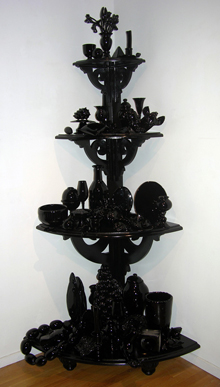
"WHATNOT II" Glass and wood by Beth Lipman, 2010.
|
"Bride" stands tall as the leading lady at the Institute of Contemporary Art's current two-woman exhibit "A Meticulous Ferment," a five-tiered pastry of sculpture glittering with as much opulence, self-importance, and fragility as the title might suggest. The towering display that is "Bride" in the front gallery is teeming with Beth Lipman's hand-blown glass objects appropriated from 17th- and 18th-century still-lifes. Clear glass goblets, candlesticks, fruit bowls, and decanters appear intact on the top level of the sculpture, where they are above eye level and least accessible to the viewer, and become broken, sloppy and shattered as the eye descends to the bottom tiers, where it may feast on imperfection. The piece is both pristinely feminine and disturbed, a decadent dowry chronicled from its reception to its bitter end.
Lipman and Kirsten Hassenfeld deal with the messages inherent in decoration and ornament, the impermanence of wealth and the waste wealth begets. Both manipulate familiar aesthetics and classical themes using alternative materials, Lipman with the translucent and homogenizing glass, and Hassenfeld using paper "masquerading" as ceramic wares, as she puts it in her artist statement. In the gallery the two complement one another, manifesting a spare and elegant show that gives breadth to the delicate works and weight to the substantial ones. The lighting is dramatic, maximizing the optical riddles presented by the glass works and lending a Baroque emotion to the works, raising their status from decorative objects to something maybe religious.
The objects featured in "Bride" are carefully rendered, and are impressive in their proliferation, displaying a control for a range of styles, from ethereal stems to heavy squirrel figurines. "Bride" provides a legend for Lipman's vocabulary of objects, which reappear in her other work in "Ferment." Returning the still life to its two-dimensional form, Lipman composed a group of her glasswares, photographed them, and printed the image to scale on Plexiglas in "Still Life with Bottles, Melons, and a Bowl of Fruit 1/3." The result is ghostly and over-exposed, bleached out like sunspots on water, the bottles and fruit defined by the evasive sea-green rim of crystal and the shadows that ground them. The subjects here do not rot, as they often would in traditional still lifes; they shatter, confusing their value.
The farthest gallery at the ICA houses Kirsten Hassenfeld's domestic installations as a shrine. "White Treen" is immediately compelling, and a graceful passage between the two women's work. Hundreds of unidentifiable trinkets are suspended at the entrance of the gallery, supported by shimmering metallic thread, performing like a cloud or a flock of birds, a floating city that crescendos towards the ceiling. At closer look, the materials this seraphic installation is composed of are mundane throwaways: salvaged caps from beer bottles and mustard jars, twist-off wine tops, golf tees, and finials pose as things of value. "Black Treen" is a fortress in the center of the gallery, an island of cairns comprised of similarly unimportant materials, sitting atop a moat made of commode mirrors.